I finished Vandread: Second Stage last week, but I was so busy this week that I haven’t had time to post any thoughts until now. As with the first series, I found myself quite pleased with this series. It’s more or less the continuation and conclusion to the first series, so this is isn’t too surprising. Potential spoilers ahead…
The men and women aboard the pirate ship Nirvana have learned to work well together and get past their cultural differences. This is a good thing because the enemy they face seems to be quite adaptable, raising the bar during each battle. We learn a lot about the enemy in this series, but it basically boils down to this: after initial colonists left from Earth, the planet suffered some sort of meltdown and the people of Earth could no longer reproduce. The Earthlings became jaded and twisted, consumed by hate and fear, eventually constructing a robotic fleet that would go after the colonists, harvesting their organs so that the Earthlings could continue to live. (I don’t know how much of this will make sense if you haven’t seen the series, but it would take too long to go through the entire story…)
The revelations are meted out at a reasonable pace and are mixed with various character development arcs that make up the series’ emotional core. Interestingly, the single most important character in the first series turns out to be something I barely noticed in the first series: the Paksis.
The Paksis, it’s alive!
The Paksis is the power plant of the Nirvana – it’s also apparently a living, sentient being. The Paksis was discovered on Earth as the colonists were beginning to expand into the galaxy. It’s unique properties made it ideal for an energy source, and so it was split into two: one remained on earth, the other was sent out with the colonists (eventually ending up on the Nirvana). The red Paksis has suffered as the people of Earth enslaved it to construct and power their harvester fleet, while the blue Paksis went on as part of the colonists’ fleet.
The Paksis is behind a lot of the confusing things that happen in the series – it’s the driving force behind the way ships combine and evolve, and it’s also got a self-preservation instinct that opened a wormhole and sent them light-years away in the first series. During many of the battles, the enemy shows the ability to adapt and evolve, mimicking many of the powers of our heroes. This lead to lots of questions until I realized that the Earthlings were simply using their Paksis to copy the fighting machines and tactics that were created by Nirvana’s crew. Steven Den Beste wrote about this a while back, using the Japanese word kiai (which essentially means “fighting spirit”) as a starting point:
All through the series the four primary characters seem to have an unreasonably fast learning curve regarding the abilities of the various versions of Vandreads as they appear, becoming adept at using them in just a few seconds. It’s not clear that the controls really matter, in fact. When they’re sufficiently motivated, the machine does what they need it to do pretty much no matter what control they use.
And afterwards they’re all weary, though Hibiki is usually the worst off in that regard. It’s because he’s been using his ki to make the machines run — because they’re not really machines.
What’s even more interesting is the cases where a character manages to raise their ki and when they do so it directly causes changes of some kind before our eyes. In Vandread it’s all about the Paksis; what they’re doing is to somehow link to the Paksis, which uses its mysterious powers to create what is needed. It isn’t necessarily a conscious need, of course. Hibiki does this more than anyone, and Meia/Dita/Jura do it to some extent, but Bart also does it once, in episode 16. (That is, the third episode of the second series.) Bart attains a sufficiently high emotional state that he is able to reach the Paksis, and as a result the Nirvana is changed to create banks of missile launchers.
Bart didn’t do that deliberately. But in the emotional state he was in at the time he didn’t question it. He was able to fully control them immediately. They did exactly what he expected them to do and needed them to do, even to where they struck only enemies and dodged around friends.
In essence, the entire series could be seen as a struggle between the red and blue Paksis, and the way the blue Paksis draws on the power of it’s crew leads to a lot of interesting character dynamics. As with the first series, there are several interesting character arcs here. One is the aformentioned arc with Bart, who becomes attached to sick little girl and is thus able to achieve an emotional state that allows him to interface with the Paksis (in order to protect the girl). It’s a fantastic episode, and it features a great reveal at the end:
Bart’s new haircut
Hibiki continues to grow, as does his relationship with Dita, and it turns out that Hibiki plays a surprisingly important role in unifying the opposition to Earth’s harvester fleet. Oh, and speaking of surprises, there’s a big one towards the end. Some hints were dropped, but I doubt anyone saw it coming (indeed, at first, I was really confused by what happened).
All in all, the story progressed well and most of the unanswered questions were resolved. We get more background on Earth, we get more detail on why Tarak and Mejale are segregated by sex (though I’m still not totally clear on that one), and of course we find out a lot more about many of the characters. There were some nitpicks and open questions, but nothing major. For instance, what was the deal with Gascogne’s return? I was happy to see her come back and all, but a little baffled as to how she managed to do so… it seemed extraneous and unnecessary to me. Also, the battles with Earth’s forces got a little repetitive, but you’d expect that in a series where our heroes engage the enemy in every episode. However, as I noted in my review of the first series, nitpicks don’t seem to bother me with this series.
In the end, it’s a solid series, and pretty much exactly what I was looking for. By the end, I was sad to see the characters go, but pleased that there was some sort of closure to the story that made sense. Thanks again to Steven for the recommendation.
As usual, more screens and comments below the fold…
This one should make Pete happy, as I’ve grown to really like the character of Barnette. In the first series, she was mostly relegated to being Jura’s man-hating sidekick, but in Second Stage, she gets a lot more to do (I still don’t like Jura though). She seems to have an affinity for “antique” projectile weapons, which comes in handy, and she gets a little more depth later in the series when she takes over the behind-the-scenes operations in Gascogne’s absence…
And here’s the obligatory Mecha shot, featuring the so-called Super Vandread, comprised of 4 ships:
In one of the later episodes in the series, Hibiki gets temporarily stranded on a planet where the people can only communicate telekenetically. This culture is naturally very spiritual and plays an important role in the story. They send Hibiki on a sort of vision quest, and of coures Hibiki returns a different man. At this point, one of the telekenetic elders places a stone on Hibiki’s forehead as an indicator that he’s completed this rite of passage.
Interestingly, there are a few other characters in the series that feature this stone. One is Rabat, who looks and dresses like the telekenetic folks, but the other one (and this is really interesting) is BC, the second-in-command of the Nirvana. I’m not sure what the deal is there, but from what happens later in the series, this is quite interesting.
I ended up taking over 100 screenshots from the series, so I could probably keep going, but since time is at a premium for me these days I’ll finish it off with a stylized shot of Hibiki.
I’ve got a few more Anime posts in the pipeline (Next up is the Read or Die OVA), though the way work has been going lately, I don’t know when I’ll actually get to them (but I will!)

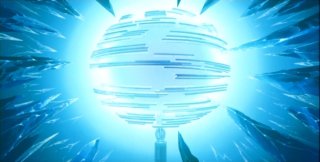
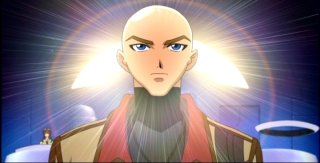
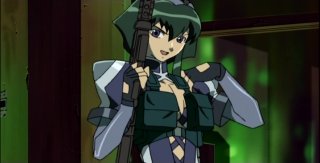
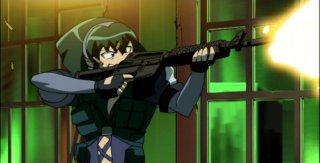
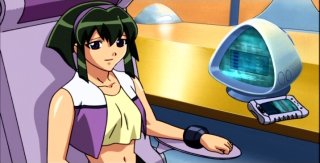
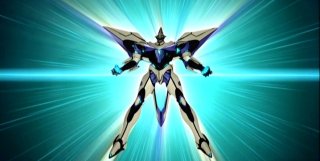
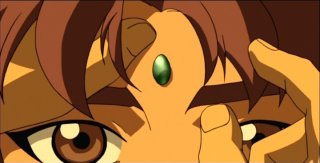
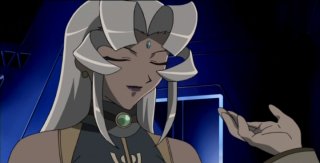
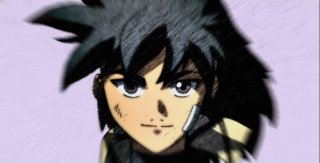
This is as good a place as any to talk about the cockpit mergers in the Vandread mergers. Some people are bothered by that.
It didn’t bother me at all, because it became clear to me early on that there was more to the Vandread mergers than just two machines linking up. The transformation happens in a flash of light, and that’s not just for visual drama. What’s actually happening is that the power of the Paksis is physically reconfiguring the two systems.
That became particularly obvious with the appearance of the Super Vandread. It doesn’t physically resemble any of the component craft at all. Even more important, it contains far more mass than the component craft combined. And large parts of it consist of transparent blue glow. It’s actually a part of the Paksis.
It turns out that the physical configurations of the three special Dreads and the one special Vanguard are rather malleable, too, almost like the Paksis forgets what it had been and redesigns it. The four ships were seriously blasted just before the appearance of the Super Vandread, but were repaired aftewards. And the next time Parfet had the hatches of Dita’s Dread open, she talks admiringly about how much the machine has changed and how much better it is.
The Vanguard and the three Dreads are not really machines, exactly. They’re semi-alive. When their pilots are in them, the combined unit has properties of life beyond that of the pilots. And to me that made sense, because each of the four pilots was inside their fighting machine at the end of the first episode of the first series, and at that time the Paksis was very confused, and may not have fully understood where the dividing line is between life and unlife.
Getting to Barnette, I think that for her the big change was that she finally came to realize the truth about Jura. Jura is a vamp and a flirt; her eye will wander. Barnette’s problem wasn’t Hibiki; he just happened to be a handy target for Jura’s wandering eye. If it hadn’t been him, it would have been someone else — and it is someone else a couple of times during the series. By the end Barnette understands, and accepts, that this is just going to be a continuing aspect of her life if she stays with Jura, which I think she will.
BC’s forehead jewel is definitely one of the mysteries of the series, but I have to say that I think it’s probably a coincidence. If there had been a connection between BC and the telepathic people, it would have come out by the end of the series, simply because there was no reason to keep that secret any longer by then.
Rabat is a series deus ex machina whose behavior makes perfect sense in the end. He keeps showing up at opportune moments, and it could have seemed contrived, except that once we finally learn where his true loyalties lie, it becomes clear that he’s been following them and keeping track of what’s going on with them — and interfering at opportune moments quite deliberately. I thought that was excellent writing.
My biggest problem with Rabat is that the weird red mecha he carries that the orang operates seemed to have much more firepower in the final battle than it really made sense for it to have. It destroyed two of the motherships, using normal ammunition, and I don’t buy that. My only explanation is that Rabat himself has a bit of connection with the Paksis and that fighting machine is enhanced as a result, but I still don’t buy it.
I’m glad you liked the series. It really is a fine one.
It’s not just that it’s a struggle between the blue and red Paksis. The original mechanism built for the blue Paksis as it existed during most of the first episode of the first series also seems to have put the Paksis in a coma. It seems that what brought it around was Dita and Hibiki’s strong need to move; that made it wake up, at which point it started responding to the situation around it as best it could. First, of course, was to stop the incoming missiles. Next was to fix everything around it.
But for most of the series, the blue Paksis is bewildered by what’s happening around it. Because it’s been asleep for all that time, it doesn’t really understand what people are. And part of the story of the series is about how the Paksis comes to understand the people in the Nirvana — and ultimately to care about them, and decide they were important.
It kept asking questions. It kept trying to get into contact with the various people it was linked to. And most of the responses it got didn’t mean anything to it. It asks Hibiki, “Why are you here?” and Hibiki answers “Because I was fed up with being picked on because I am small, and a third class citizen.” That didn’t tell the Paksis anything.
It wasn’t until Hibiki was in the cave that he finally figured out the thrust of the questions the Paksis was asking, and began to give the Paksis answers that truly illuminated the situation. But I think the moment in the next episode where Misty talks to the Paksis (through Pyoro) was nearly as important, because the Paksis was trying to deal with the question of being unique and out of place, just as Misty was. The Paksis then saw Meia and Dita show up and tell Misty that she had a place with them and was welcome — and I think the Paksis understood that the same was true for it.
Of course, in the last episode the Paksis finally acts on it.
I actively disliked the gun nut episode, but otherwise I think I selected Barnette well at the start. It’s too bad she’s not part of the combining team. I wonder why (well, aside from the writer’s fancy).
I still do not buy into the living Paksis, I find the idea phony. I am still nursing my plans to really rip on it. Other than that, great show, I’m glad you liked it.
The five members of the crew of the Super Vandread were all in the engine room of the Ikazuchi at the end of episode 1 of the first series when the Paksis woke up, and were pulled into the Paksis at that time. Barnette wasn’t one of them, and that’s why she isn’t part of the crew of the Super Vandread.
This is the problem with watching the series only once. The writers clearly knew what they were doing, but I didn’t know what the Paksis was at the beginning of the series, so I probably didn’t notice some of the smaller signs (same thing with the big surprise towards the end of the series, which was a total shock). I never put together some of the finer points you mention, but it all makes sense.
As far as Rabat goes, I don’t especially love him, but he does kinda remind me of the Enoch Root character from Cryptonomicon in that they both seem to be operating behind the scenes and helping out when they can (though Root is way cooler:P)
Pete, I didn’t especially love the episode, but I liked that Barnette became something more than Jura’s (jealous, to Steven’s point) sidekick, and from that point on, I liked the character…
All in all though, very good series:)